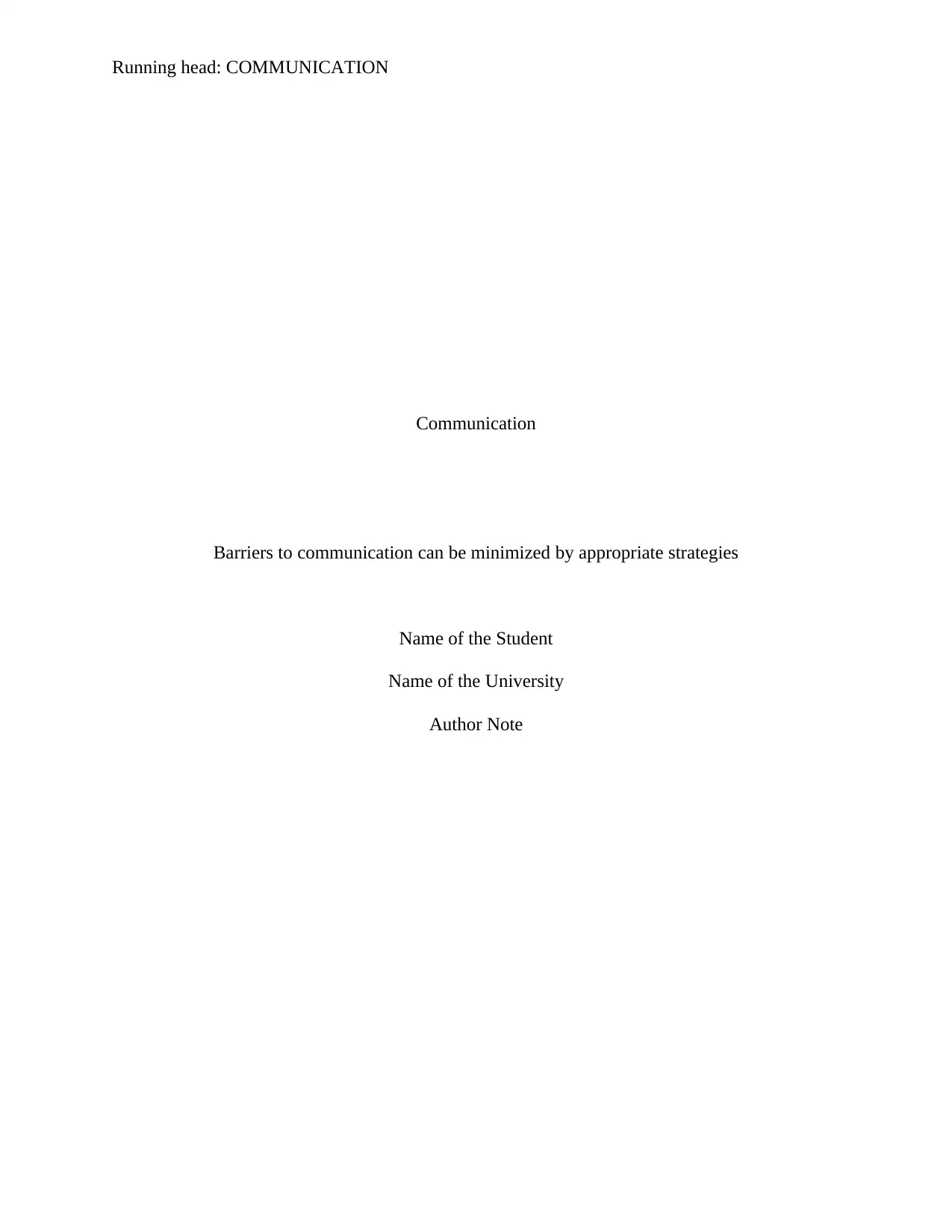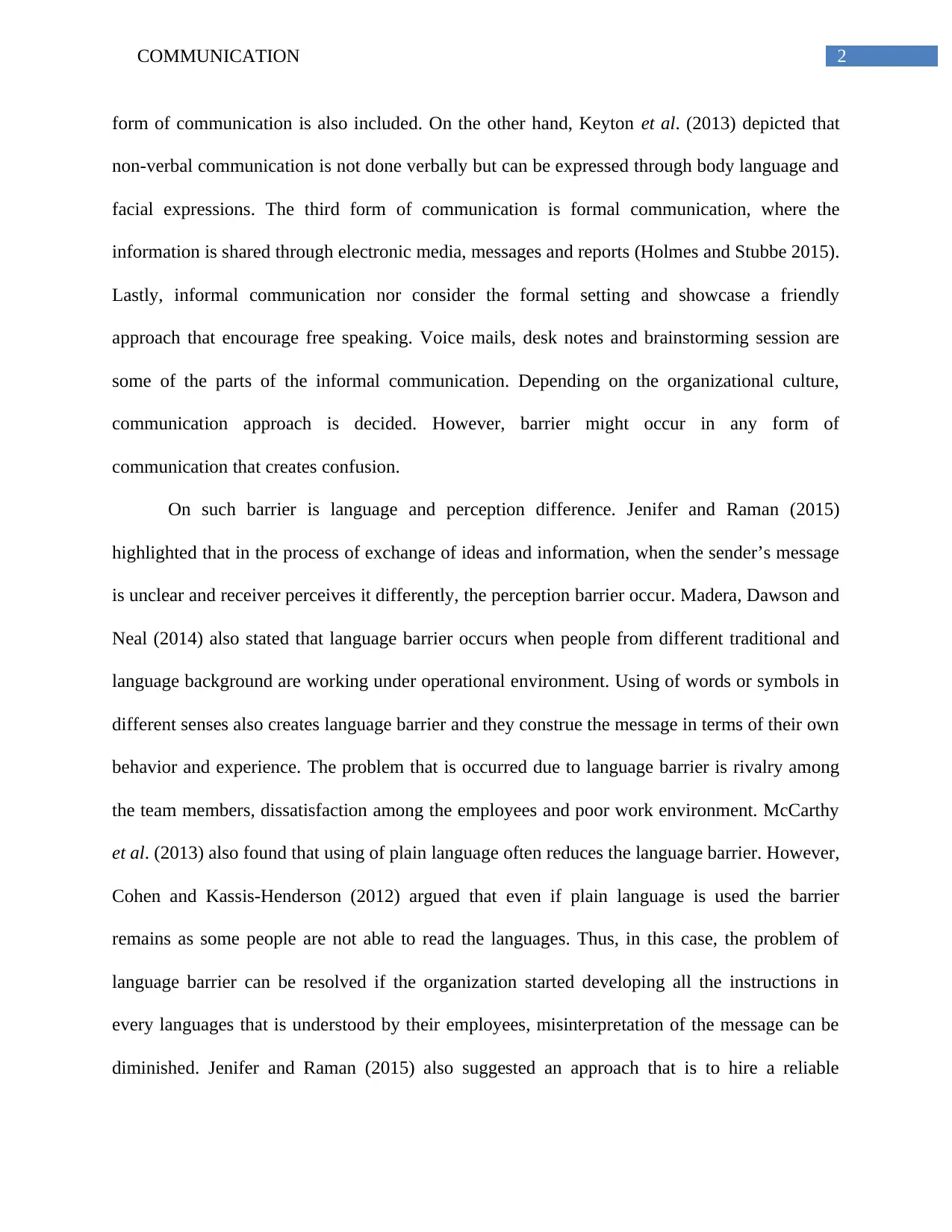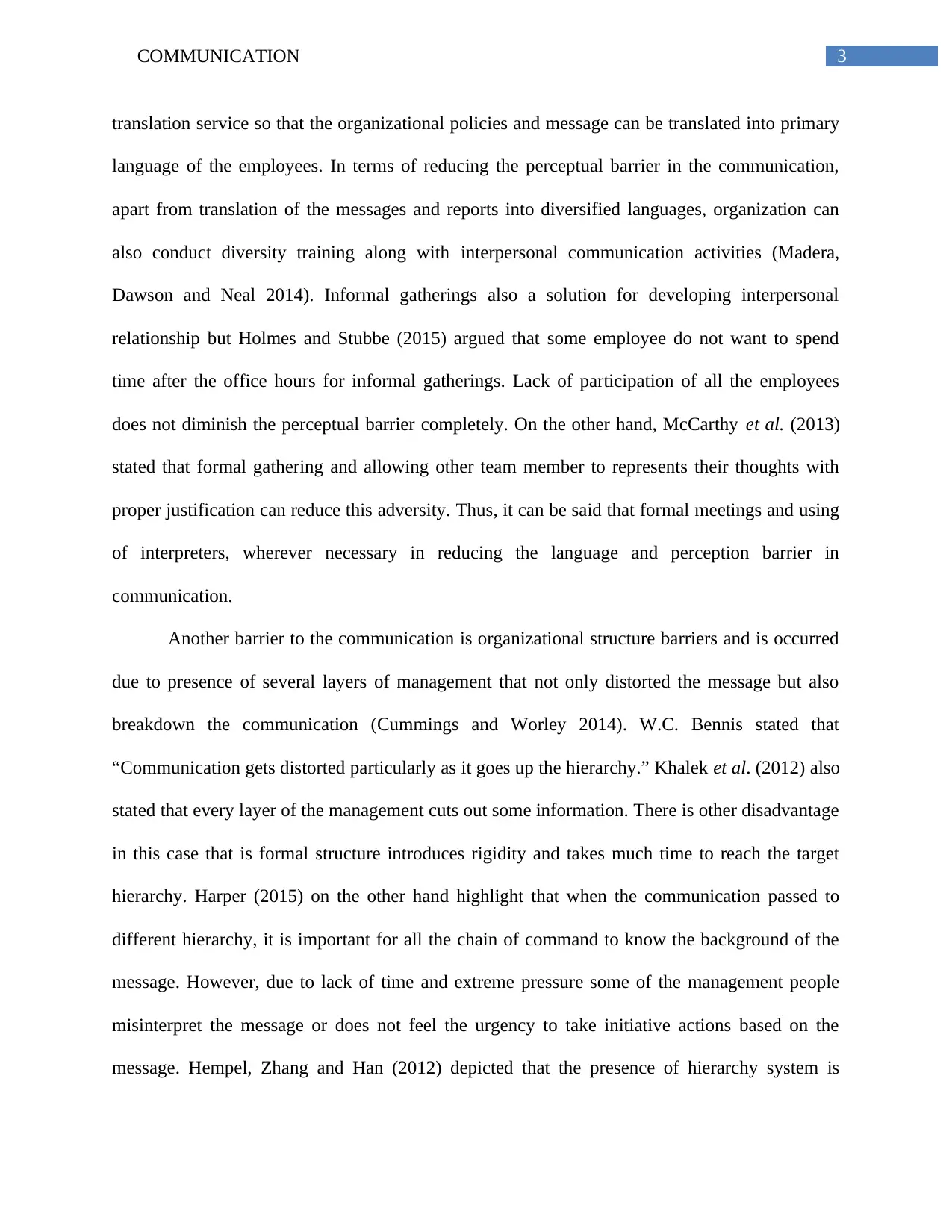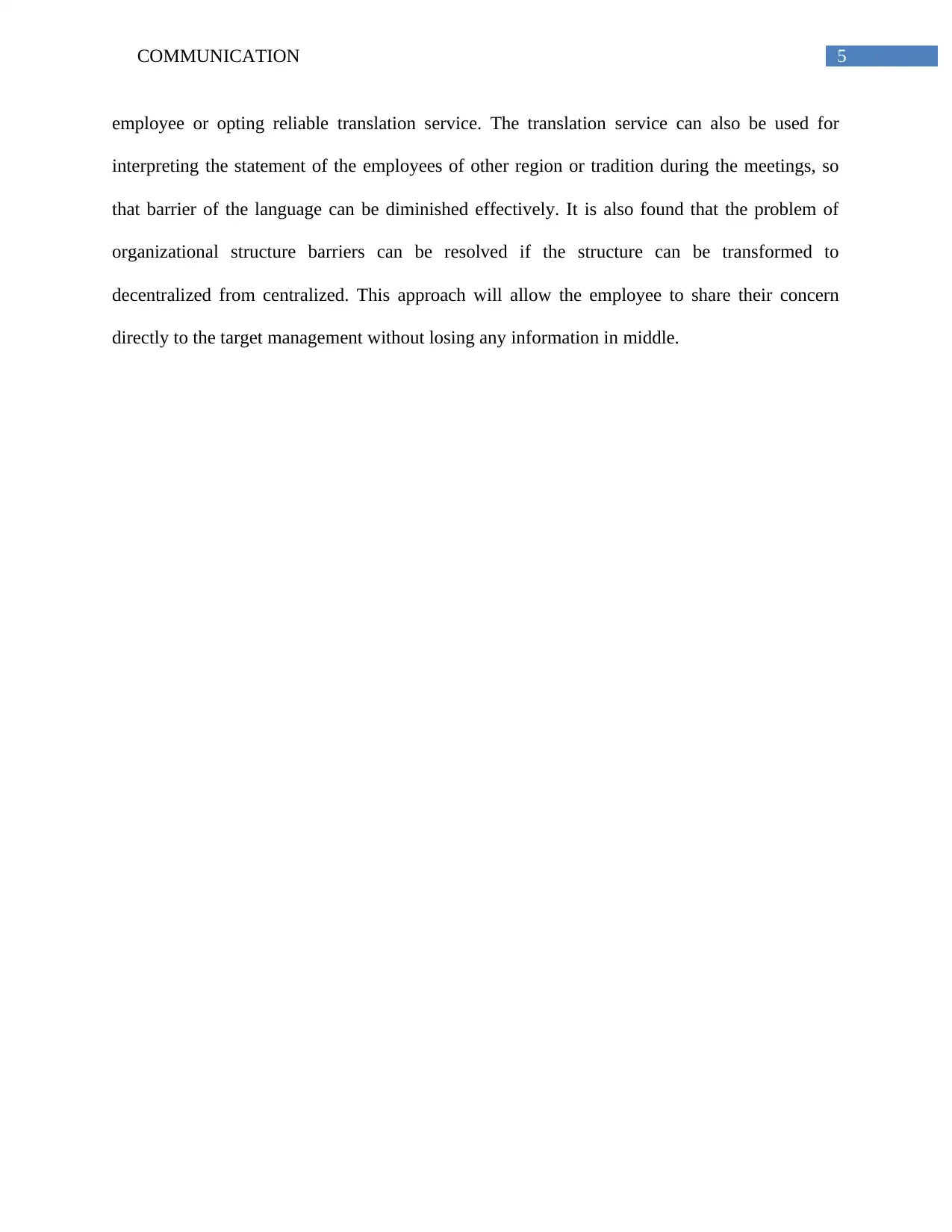An Analysis of Communication Barriers and Strategies Essay
VerifiedAdded on 2023/06/09
|8
|1951
|97
Essay
AI Summary
This essay delves into the critical aspects of communication within the workplace, focusing on two primary barriers: perceptual and language differences, and organizational structure barriers. The essay highlights how language barriers can lead to misinterpretations and dissatisfaction among employees, especially in diverse work environments. It suggests strategies such as translating organizational communications into multiple languages and utilizing translation services. Furthermore, it examines how hierarchical structures can distort messages and impede effective communication. The essay proposes a shift from centralized to decentralized organizational structures to foster a more open and direct communication flow, enabling employees to share their concerns directly with management. The conclusion reinforces the importance of overcoming these barriers through strategic implementation of language support, diversity training, and organizational restructuring to enhance overall communication and productivity.

Running head: COMMUNICATION
Communication
Barriers to communication can be minimized by appropriate strategies
Name of the Student
Name of the University
Author Note
Communication
Barriers to communication can be minimized by appropriate strategies
Name of the Student
Name of the University
Author Note
Paraphrase This Document
Need a fresh take? Get an instant paraphrase of this document with our AI Paraphraser

1COMMUNICATION
Introduction
Communication fosters the good working relationships and depending on the
communication chain in an organization, the morale, productivity and commitment can be
enhanced (Broadbent 2013). However, maintaining an effective communication process can be
interrupted due to several reasons and one of them is language difference. Castells (2013) stated
that contemporary organizations adopts employee diversity for enhancing the talent pool and
employee performance but faces perceptual and language differences due to which barrier in the
communication arises. Bonaccio et al. (2016) also depicted that other barriers like physical
barriers in non-verbal communication and overloaded information creates problem in effective
communication. In some case, misinterpretation of verbal communication arises due to presence
of several level of managerial hierarchy. Quintanilla and Wahl (2015) also portrays that in this
case, delay in communicating the message is a common problem. However, these problem can
be resolved if proper strategies can be implemented. This essay aims for highlighting two
barriers to the communication and analyze two corresponding strategies critically that can
incorporated for making the communication system more effective. In this assessment the first
communication barrier that is taken into consideration is perceptual and language differences;
whereas, the second barrier that is focused is organizational structure barriers.
Discussion
Communication is for daily interaction so that the thoughts from the observation can be
interpreted. Broadbent (2013) stated that there are four different kinds of communication- verbal,
non-verbal, formal communication and informal communication. Verbal communication is a
process, where people share their concern through words. In this kind of communication written
Introduction
Communication fosters the good working relationships and depending on the
communication chain in an organization, the morale, productivity and commitment can be
enhanced (Broadbent 2013). However, maintaining an effective communication process can be
interrupted due to several reasons and one of them is language difference. Castells (2013) stated
that contemporary organizations adopts employee diversity for enhancing the talent pool and
employee performance but faces perceptual and language differences due to which barrier in the
communication arises. Bonaccio et al. (2016) also depicted that other barriers like physical
barriers in non-verbal communication and overloaded information creates problem in effective
communication. In some case, misinterpretation of verbal communication arises due to presence
of several level of managerial hierarchy. Quintanilla and Wahl (2015) also portrays that in this
case, delay in communicating the message is a common problem. However, these problem can
be resolved if proper strategies can be implemented. This essay aims for highlighting two
barriers to the communication and analyze two corresponding strategies critically that can
incorporated for making the communication system more effective. In this assessment the first
communication barrier that is taken into consideration is perceptual and language differences;
whereas, the second barrier that is focused is organizational structure barriers.
Discussion
Communication is for daily interaction so that the thoughts from the observation can be
interpreted. Broadbent (2013) stated that there are four different kinds of communication- verbal,
non-verbal, formal communication and informal communication. Verbal communication is a
process, where people share their concern through words. In this kind of communication written

2COMMUNICATION
form of communication is also included. On the other hand, Keyton et al. (2013) depicted that
non-verbal communication is not done verbally but can be expressed through body language and
facial expressions. The third form of communication is formal communication, where the
information is shared through electronic media, messages and reports (Holmes and Stubbe 2015).
Lastly, informal communication nor consider the formal setting and showcase a friendly
approach that encourage free speaking. Voice mails, desk notes and brainstorming session are
some of the parts of the informal communication. Depending on the organizational culture,
communication approach is decided. However, barrier might occur in any form of
communication that creates confusion.
On such barrier is language and perception difference. Jenifer and Raman (2015)
highlighted that in the process of exchange of ideas and information, when the sender’s message
is unclear and receiver perceives it differently, the perception barrier occur. Madera, Dawson and
Neal (2014) also stated that language barrier occurs when people from different traditional and
language background are working under operational environment. Using of words or symbols in
different senses also creates language barrier and they construe the message in terms of their own
behavior and experience. The problem that is occurred due to language barrier is rivalry among
the team members, dissatisfaction among the employees and poor work environment. McCarthy
et al. (2013) also found that using of plain language often reduces the language barrier. However,
Cohen and Kassis-Henderson (2012) argued that even if plain language is used the barrier
remains as some people are not able to read the languages. Thus, in this case, the problem of
language barrier can be resolved if the organization started developing all the instructions in
every languages that is understood by their employees, misinterpretation of the message can be
diminished. Jenifer and Raman (2015) also suggested an approach that is to hire a reliable
form of communication is also included. On the other hand, Keyton et al. (2013) depicted that
non-verbal communication is not done verbally but can be expressed through body language and
facial expressions. The third form of communication is formal communication, where the
information is shared through electronic media, messages and reports (Holmes and Stubbe 2015).
Lastly, informal communication nor consider the formal setting and showcase a friendly
approach that encourage free speaking. Voice mails, desk notes and brainstorming session are
some of the parts of the informal communication. Depending on the organizational culture,
communication approach is decided. However, barrier might occur in any form of
communication that creates confusion.
On such barrier is language and perception difference. Jenifer and Raman (2015)
highlighted that in the process of exchange of ideas and information, when the sender’s message
is unclear and receiver perceives it differently, the perception barrier occur. Madera, Dawson and
Neal (2014) also stated that language barrier occurs when people from different traditional and
language background are working under operational environment. Using of words or symbols in
different senses also creates language barrier and they construe the message in terms of their own
behavior and experience. The problem that is occurred due to language barrier is rivalry among
the team members, dissatisfaction among the employees and poor work environment. McCarthy
et al. (2013) also found that using of plain language often reduces the language barrier. However,
Cohen and Kassis-Henderson (2012) argued that even if plain language is used the barrier
remains as some people are not able to read the languages. Thus, in this case, the problem of
language barrier can be resolved if the organization started developing all the instructions in
every languages that is understood by their employees, misinterpretation of the message can be
diminished. Jenifer and Raman (2015) also suggested an approach that is to hire a reliable
⊘ This is a preview!⊘
Do you want full access?
Subscribe today to unlock all pages.

Trusted by 1+ million students worldwide

3COMMUNICATION
translation service so that the organizational policies and message can be translated into primary
language of the employees. In terms of reducing the perceptual barrier in the communication,
apart from translation of the messages and reports into diversified languages, organization can
also conduct diversity training along with interpersonal communication activities (Madera,
Dawson and Neal 2014). Informal gatherings also a solution for developing interpersonal
relationship but Holmes and Stubbe (2015) argued that some employee do not want to spend
time after the office hours for informal gatherings. Lack of participation of all the employees
does not diminish the perceptual barrier completely. On the other hand, McCarthy et al. (2013)
stated that formal gathering and allowing other team member to represents their thoughts with
proper justification can reduce this adversity. Thus, it can be said that formal meetings and using
of interpreters, wherever necessary in reducing the language and perception barrier in
communication.
Another barrier to the communication is organizational structure barriers and is occurred
due to presence of several layers of management that not only distorted the message but also
breakdown the communication (Cummings and Worley 2014). W.C. Bennis stated that
“Communication gets distorted particularly as it goes up the hierarchy.” Khalek et al. (2012) also
stated that every layer of the management cuts out some information. There is other disadvantage
in this case that is formal structure introduces rigidity and takes much time to reach the target
hierarchy. Harper (2015) on the other hand highlight that when the communication passed to
different hierarchy, it is important for all the chain of command to know the background of the
message. However, due to lack of time and extreme pressure some of the management people
misinterpret the message or does not feel the urgency to take initiative actions based on the
message. Hempel, Zhang and Han (2012) depicted that the presence of hierarchy system is
translation service so that the organizational policies and message can be translated into primary
language of the employees. In terms of reducing the perceptual barrier in the communication,
apart from translation of the messages and reports into diversified languages, organization can
also conduct diversity training along with interpersonal communication activities (Madera,
Dawson and Neal 2014). Informal gatherings also a solution for developing interpersonal
relationship but Holmes and Stubbe (2015) argued that some employee do not want to spend
time after the office hours for informal gatherings. Lack of participation of all the employees
does not diminish the perceptual barrier completely. On the other hand, McCarthy et al. (2013)
stated that formal gathering and allowing other team member to represents their thoughts with
proper justification can reduce this adversity. Thus, it can be said that formal meetings and using
of interpreters, wherever necessary in reducing the language and perception barrier in
communication.
Another barrier to the communication is organizational structure barriers and is occurred
due to presence of several layers of management that not only distorted the message but also
breakdown the communication (Cummings and Worley 2014). W.C. Bennis stated that
“Communication gets distorted particularly as it goes up the hierarchy.” Khalek et al. (2012) also
stated that every layer of the management cuts out some information. There is other disadvantage
in this case that is formal structure introduces rigidity and takes much time to reach the target
hierarchy. Harper (2015) on the other hand highlight that when the communication passed to
different hierarchy, it is important for all the chain of command to know the background of the
message. However, due to lack of time and extreme pressure some of the management people
misinterpret the message or does not feel the urgency to take initiative actions based on the
message. Hempel, Zhang and Han (2012) depicted that the presence of hierarchy system is
Paraphrase This Document
Need a fresh take? Get an instant paraphrase of this document with our AI Paraphraser

4COMMUNICATION
known as centralized organizational structure which comprised of many disadvantageous aspects
like limited communication, high level of inflexibility and interpreting the instructions in
different ways. All these problems create greater dissatisfaction among the employees which not
only reduces their productivity but also generate the sense of voluntary turnover. Cummings and
Worley (2014) from his research found that transforming the organizational structure from
centralized to the de-centralized; an organization creates two-ways active communication system
through which the employees can share their concern direct to the targeted hierarchy. Garicano
and Wu (2012) also stated that the information that is shared with the higher management,
should be in a formal way and contain no obnoxious statement that can diminish the
communication. Harper (2015) also suggests that language training should also be considered for
all the employees so that they can learn to develop formal mails, reports and message.
Conclusion
Communication in a working place play a crucial role in distributing thoughts and idea
using words; however it is found that there some barrier that might occur while making
communication. The two communication barrier discussed in this assessment is language and
perceptual barrier and the second is organizational structure barrier. It is also fund that language
barrier and perceptual barrier are linked together as employee when do not understand the
language of the report, they try to interpret the message based on their perception or experience.
On the other hand, it is also found that presence of greater hierarchy of management in a
workplace also diminishes the quality of the communication. The main reason is that every level
of the management conveys the message in their terms and often omit a bit of information. The
solution that is suggested in this assessment for overcoming the language and perceptual barrier
in communication is developing all the organizational reports in the primary language of the
known as centralized organizational structure which comprised of many disadvantageous aspects
like limited communication, high level of inflexibility and interpreting the instructions in
different ways. All these problems create greater dissatisfaction among the employees which not
only reduces their productivity but also generate the sense of voluntary turnover. Cummings and
Worley (2014) from his research found that transforming the organizational structure from
centralized to the de-centralized; an organization creates two-ways active communication system
through which the employees can share their concern direct to the targeted hierarchy. Garicano
and Wu (2012) also stated that the information that is shared with the higher management,
should be in a formal way and contain no obnoxious statement that can diminish the
communication. Harper (2015) also suggests that language training should also be considered for
all the employees so that they can learn to develop formal mails, reports and message.
Conclusion
Communication in a working place play a crucial role in distributing thoughts and idea
using words; however it is found that there some barrier that might occur while making
communication. The two communication barrier discussed in this assessment is language and
perceptual barrier and the second is organizational structure barrier. It is also fund that language
barrier and perceptual barrier are linked together as employee when do not understand the
language of the report, they try to interpret the message based on their perception or experience.
On the other hand, it is also found that presence of greater hierarchy of management in a
workplace also diminishes the quality of the communication. The main reason is that every level
of the management conveys the message in their terms and often omit a bit of information. The
solution that is suggested in this assessment for overcoming the language and perceptual barrier
in communication is developing all the organizational reports in the primary language of the

5COMMUNICATION
employee or opting reliable translation service. The translation service can also be used for
interpreting the statement of the employees of other region or tradition during the meetings, so
that barrier of the language can be diminished effectively. It is also found that the problem of
organizational structure barriers can be resolved if the structure can be transformed to
decentralized from centralized. This approach will allow the employee to share their concern
directly to the target management without losing any information in middle.
employee or opting reliable translation service. The translation service can also be used for
interpreting the statement of the employees of other region or tradition during the meetings, so
that barrier of the language can be diminished effectively. It is also found that the problem of
organizational structure barriers can be resolved if the structure can be transformed to
decentralized from centralized. This approach will allow the employee to share their concern
directly to the target management without losing any information in middle.
⊘ This is a preview!⊘
Do you want full access?
Subscribe today to unlock all pages.

Trusted by 1+ million students worldwide

6COMMUNICATION
Reference
Bonaccio, S., O’Reilly, J., O’Sullivan, S.L. and Chiocchio, F., 2016. Nonverbal behavior and
communication in the workplace: A review and an agenda for research. Journal of
Management, 42(5), pp.1044-1074.
Broadbent, D.E., 2013. Perception and communication. Elsevier.
Castells, M., 2013. Communication power. OUP Oxford.
Cohen, L. and Kassis-Henderson, J., 2012. Language use in establishing rapport and building
relations: implications for international teams and management education. Management &
Avenir, (5), pp.185-207.
Cummings, T.G. and Worley, C.G., 2014. Organization development and change. Cengage
learning.
Garicano, L. and Wu, Y., 2012. Knowledge, communication, and organizational
capabilities. Organization science, 23(5), pp.1382-1397.
Harper, C., 2015. Organizations: Structures, processes and outcomes. Routledge.
Hempel, P.S., Zhang, Z.X. and Han, Y., 2012. Team empowerment and the organizational
context: Decentralization and the contrasting effects of formalization. Journal of
management, 38(2), pp.475-501.
Holmes, J. and Stubbe, M., 2015. Power and politeness in the workplace: A sociolinguistic
analysis of talk at work. Routledge.
Jenifer, R.D. and Raman, G.P., 2015. Cross-cultural communication barriers in the
workplace. Internafional Journal of Management, 6(1), pp.348-351.
Reference
Bonaccio, S., O’Reilly, J., O’Sullivan, S.L. and Chiocchio, F., 2016. Nonverbal behavior and
communication in the workplace: A review and an agenda for research. Journal of
Management, 42(5), pp.1044-1074.
Broadbent, D.E., 2013. Perception and communication. Elsevier.
Castells, M., 2013. Communication power. OUP Oxford.
Cohen, L. and Kassis-Henderson, J., 2012. Language use in establishing rapport and building
relations: implications for international teams and management education. Management &
Avenir, (5), pp.185-207.
Cummings, T.G. and Worley, C.G., 2014. Organization development and change. Cengage
learning.
Garicano, L. and Wu, Y., 2012. Knowledge, communication, and organizational
capabilities. Organization science, 23(5), pp.1382-1397.
Harper, C., 2015. Organizations: Structures, processes and outcomes. Routledge.
Hempel, P.S., Zhang, Z.X. and Han, Y., 2012. Team empowerment and the organizational
context: Decentralization and the contrasting effects of formalization. Journal of
management, 38(2), pp.475-501.
Holmes, J. and Stubbe, M., 2015. Power and politeness in the workplace: A sociolinguistic
analysis of talk at work. Routledge.
Jenifer, R.D. and Raman, G.P., 2015. Cross-cultural communication barriers in the
workplace. Internafional Journal of Management, 6(1), pp.348-351.
Paraphrase This Document
Need a fresh take? Get an instant paraphrase of this document with our AI Paraphraser

7COMMUNICATION
Keyton, J., Caputo, J.M., Ford, E.A., Fu, R., Leibowitz, S.A., Liu, T., Polasik, S.S., Ghosh, P.
and Wu, C., 2013. Investigating verbal workplace communication behaviors. The Journal of
Business Communication (1973), 50(2), pp.152-169.
Khalek, A., Amin, C., Abdrabou, A., Adachi, F., Afifi, H., Agrell, E., Aguilar, T., Ai, B., Aissa,
S., Akyildiz, I.F. and Al-Zubaidy, H., 2012 Index IEEE Journal on Selected Areas in
Communications Vol. 30.
Madera, J.M., Dawson, M. and Neal, J.A., 2014. Managing language barriers in the workplace:
The roles of job demands and resources on turnover intentions. International Journal of
Hospitality Management, 42, pp.117-125.
McCarthy, J., Cassidy, I., Graham, M.M. and Tuohy, D., 2013. Conversations through barriers of
language and interpretation. British journal of nursing, 22(6), pp.335-339.
Quintanilla, K.M. and Wahl, S.T., 2015. Business and professional communication: keys for
workplace excellence. Sage Publications.
Keyton, J., Caputo, J.M., Ford, E.A., Fu, R., Leibowitz, S.A., Liu, T., Polasik, S.S., Ghosh, P.
and Wu, C., 2013. Investigating verbal workplace communication behaviors. The Journal of
Business Communication (1973), 50(2), pp.152-169.
Khalek, A., Amin, C., Abdrabou, A., Adachi, F., Afifi, H., Agrell, E., Aguilar, T., Ai, B., Aissa,
S., Akyildiz, I.F. and Al-Zubaidy, H., 2012 Index IEEE Journal on Selected Areas in
Communications Vol. 30.
Madera, J.M., Dawson, M. and Neal, J.A., 2014. Managing language barriers in the workplace:
The roles of job demands and resources on turnover intentions. International Journal of
Hospitality Management, 42, pp.117-125.
McCarthy, J., Cassidy, I., Graham, M.M. and Tuohy, D., 2013. Conversations through barriers of
language and interpretation. British journal of nursing, 22(6), pp.335-339.
Quintanilla, K.M. and Wahl, S.T., 2015. Business and professional communication: keys for
workplace excellence. Sage Publications.
1 out of 8
Related Documents
Your All-in-One AI-Powered Toolkit for Academic Success.
+13062052269
info@desklib.com
Available 24*7 on WhatsApp / Email
![[object Object]](/_next/static/media/star-bottom.7253800d.svg)
Unlock your academic potential
Copyright © 2020–2025 A2Z Services. All Rights Reserved. Developed and managed by ZUCOL.




